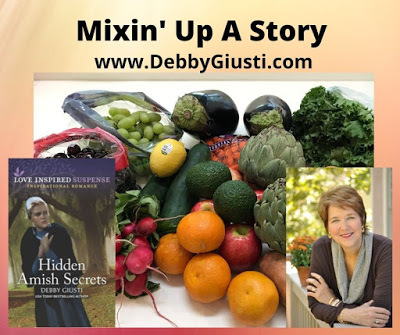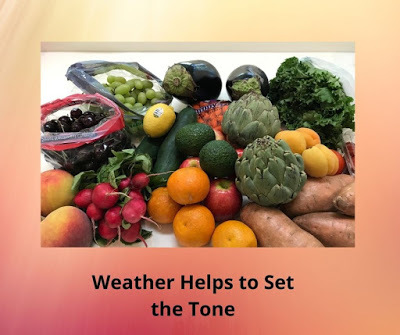Mixin' Up A Story
 By Debby Giusti
By Debby Giusti True confession: I’m a foodie, and I love to create new recipes, especially stir-fry meals where I add lots of ingredients to the mix. I start by sautéing garlic, onions and colorful peppers in extra virgin olive oil, then I add chicken, sliced steak or shrimp seasoned with sea salt and ground pepper as well as grated ginger and cayenne. If I want to add a South of the Border slant, I’ll include cumin, cilantro, chili powder and turmeric.
As the flavors meld, I add vegetables in various combinations depending on my mood and what’s in my refrigerator, such as carrots, tomatoes, fresh mushrooms, cauliflower and snow peas. A dash of Kikkoman’s soy sauce, a sprinkle of Italian salad dressing and a splash of wine provide an even more flavorful mix.
Chicken or beef stock adds volume and can be thickened with corn starch or flour. Lemon juice, or lime for Mexican dishes, awakens the flavors even more. Once the veggies are cooked, I add fresh spinach for color and serve the dish in a soup bowl or ladled over rice or pasta. Chopped parsley is a lovely finisher; chopped chives are as well, and no matter what’s in the mix, I cover the dish with grated Parmesan cheese.
Having a lot of ingredients from which to choose makes cooking an exciting adventure and ensures each meal is a delicious culinary delight. At least, that’s my hope.
That same process applies to writing. The writer takes various literary elements and mixes them together in a unique way to make her story come to life. The elements are the ingredients the writer uses as she creates her next bestseller, and the more “ingredients” she has at her disposal, the faster the words fly across the computer screen.
Every romance story has a hero and heroine. That’s a given. Adding secondary characters flavors the story and paints a clearer picture of the main characters and how they relate to others. A good friend can be a sounding board. She can offer insight into past mistakes or warn about impending danger, either physical or emotional and most especially about matters of the heart.

If that friend is also a mentor, he offers advice the hero can accept or reject. In either case, the reader learns more about the protagonist and how he handles various situations or tackles problems in relation to the way he reacts to the mentor’s counsel.
A foil reflects the lead character’s traits either in a positive or negative way. A nagging wife becomes the foil to her even-tempered, spinster sister protagonist who has given up on love. The heroine’s good qualities shine more brightly and are revealed more fully when compared to her abrasive sibling.
Children are delightful secondary characters who add levity and can either lighten the mood or enhance the angst. A petulant teen disrupts the status quo, whereas an adorable five-year-old can soften the hardest of hearts. When the main characters are forced into fish-out-of-water-situations, such as the Atlanta cop who becomes the guardian of three Amish children in my next book, the protagonist has a lot to learn about not only raising kids but also about himself.
Use canine or feline "characters" to up the salability of your story. If the hero or heroine lives alone, a dog can be a special friend and an empathetic listening ear. On the other hand, a frisky mutt can complicate a story by getting into trouble—or by getting the hero in trouble—such as when Fido overturns the pretty neighbor’s trash can or scares her beloved kitten up a tree. Think of how many Hallmark movies include a pet that brings the hero and heroine together, and you’ll realize that adding a furry friend to your story is a win-win. Readers love pets, and when pups and kittens are pictured on the cover, they sell books—a fact marketing knows so well.
Be sure to sprinkle a subplot into your mix. A favorite is when secondary characters fall in love. Giving an older character, perhaps a widowed parent or grandparent, a second chance at love brings a smile to readers lips and keeps them turning the page to ensure everyone finds their happily ever after.

Weather helps to set the tone, so depending on the season, allow Mother Nature to play a role in your story. Use scorching heat, torrential rain or gale force winds to up the tension, and conversely allow warm, ocean breezes and moonlight over the water to set the scene for romance. Blue skies brighten any story whereas freezing rain sends a chill down readers’ spines. Couple that cold with a heroine running for her life and you’ve added an extra adrenaline kick. Whether suspense or sweet romance, the sun always shines at the end when the hero and heroine declare their love or stand before an altar and boldly proclaim “I Do!”
Choose a setting that builds interest in your story. The historical relevance of a certain place or the significance of various local landmarks add authenticity and provide educational takeaways for the reader.
Conflict, both external and internal, is an important staple to any story. The main goal that seems impossible to achieve in the beginning moves the action forward, while other smaller problems bubble to the surface as the plot thickens.
Internal conflict should be life changing, at least in the hero’s or heroine’s mind. Readers have baggage, and they’ll identify with flawed characters who struggle with significant problems. The deeper the conflict, the more the readers will enjoy the resolution.

Throw in a secret—or two or three—to tweak your reader’s interest and build anticipation. If the hero and heroine both harbor secrets and perhaps carry guilt about the same incident that occurred in the past, all the better. Remember the two dogs/one bone technique for external conflict when the hero and heroine are vying for the same job or parcel of real estate can also apply to internal conflict when they’re both worried about the responsibility they bear for a tragic situation that occurred years earlier.
Creating a well-blended story with lots of exciting elements will keep the editor engaged and the readers eager to read the story. Whether you’re cooking dinner or writing a story, ensure you have lots of delicious ingredients to turn your meal—or your next book—into a culinary or literary masterpiece that’s sure to please.
What are you mixin’ up in your stories? Share the elements you add to spice up your writing. Let me know in the comment section if you would like to be entered in a drawing for a copy of HIDDEN AMISH SECRETS.
The coffee’s hot and tea is available along with a yummy chicken stir fry. I hope you enjoy the meal.
Happy writing! Happy reading!
Wishing you abundant blessings,
Debby Giusti

Her temporary Amish homecoming
could get her killed.
Julianne Graber left her Amish life behind after a family tragedy, but now she’s back to sell the family home— and someone’s dead set on getting rid of her. With her neighbor William Lavy by her side, Julianne must uncover dangerous secrets to make sense of the past and present. Can she find justice for her family—and a future with Will—before the killer hits his target?
Order on Amazon!



